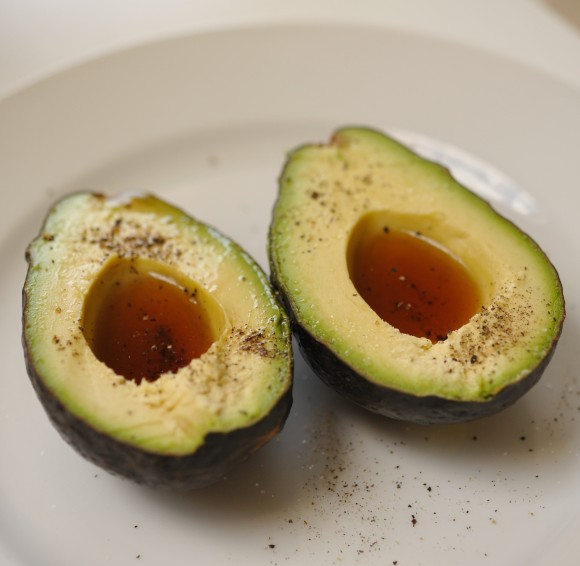by Sam Tackeff | Apr 15, 2013 | Braises, Meat, Salads
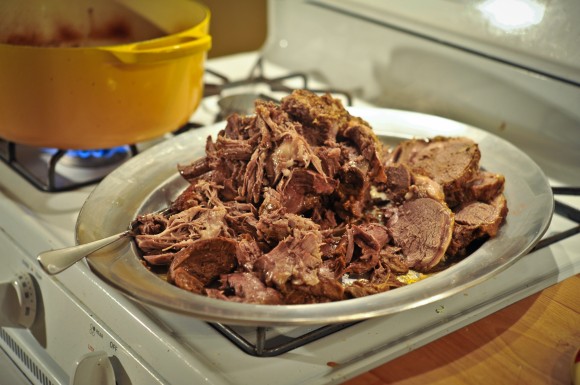
Editor’s note: thank you so much to everyone who voted for me in the competition! This was not only the winning recipe, but the winning competition dish. What a blast!
Last week I ran out of my office in Haymarket, laden with my massive computer bag, and wearing flats, managed to sprint over to Tavern Road, a little over a mile, in 14 minutes. For a lamb party.
Tavern Road is the newest restaurant to pop up on Congress Street in Fort Point, and I’ve loved what I’ve seen (and tasted) so far. The restaurant is modern American, with as much attention paid to vegetables as to charcuterie. Last week I stopped by for a little pre-dinner, where I made my way through three vegetable dishes and a few slices of ham. The one that stood out was the grilled broccoli rabe with vanilla and hazelnuts, but everything was very good. They also have a well worn selection of cookbooks on the open kitchen counter, including Bertolli’s ‘Cooking by Hand’, which always leads me to judge a cook favorably. I’ll be stopping by often, so I’ll be sure to report back soon. {The only warning I have is that most of the parking turns into residential past 6pm. I learned this not because of the signs, but because of the 40 dollar parking ticket I earned last week for moving my car two blocks over from the lot to near the restaurant… yeesh.}
So about this party – the kind folks at BostonChefs.com invited me to participate in the American Lamb Board Lamb Pro-Am – a promotional event hooking up bloggers with local chefs to celebrate the most delicious of meats. (Seriously, I love it more than bacon.) At the party, we were served lamb meatballs, and provided with lamb swag, and a *massive* boneless leg of lamb to have our way with (and come up with a recipe for the competition).
I don’t usually participate in contests – let’s face it, they usually end up being a popularity thing – but I couldn’t turn down all this meaty goodness (especially in the midst of my gym challenge!). So here’s the deal – voting will begin on 4/17, and if you like lamb, and the possibility of hooking me up with a local chef to make you delicious noms, ewe should vote for me! {UPDATE: Please VOTE for me here: http://bit.ly/ProAm2013 !! Click on that Lamb Mechoui + Moroccan Marinated Carrots on the right, and help me be victorious! Voting will end next Friday, 4/26 at 5pm}
If you, like me, missed out on the Lamb Jam last month (everyone who went managed to make me jealous and bitter), never fear, the winners will be cooking up food for the masses at the official Lamb Pro-Am event on May 19th. If you’d like to gorge yourselves on the winning dishes, Pro-Am ticket sales have begun! Here’s a link to the event page: http://bit.ly/ProAm2013 and here’s a link to the ticket sales page: http://bit.ly/ProAmTix
Without further ado, let me wax poetic about lamb. It’s a little long, forgive me. If you get bored, just scroll though the photos – I did my best to make them lamb-tastic.
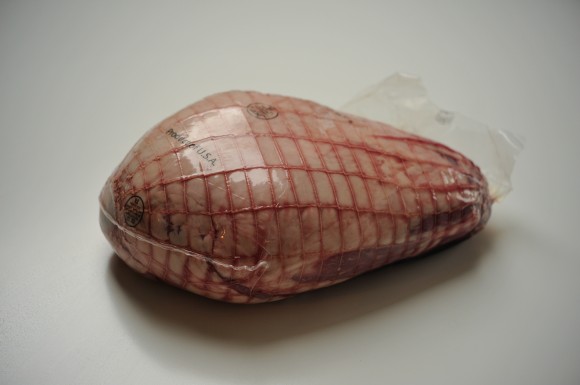
I think I’ve mentioned it often enough, but if you are new here, much of my culinary background comes from my Jewish and Turkish heritage, with a smattering of influence from French, Greek, and Moroccan relatives. I’ve grown up in a family who loves to cook, and who more importantly loves to eat – and so I’ve done a lot of it, all over the world, with dedication and gusto.
In my kitchen, Middle Eastern and North African flavors are the most prevalent. I love the rich, warm, sometimes smoky spices. I like spices that pack a punch – I cook with fistfuls of fresh herbs, particularly parsley and mint, and I use a lot of citrus.
Turks eat a lot of lamb – for centuries it has been the most popular type of meat, and pops up in hundreds of different dishes. You’ll commonly find it made into kebabs, pilafs, köfte (meatballs), and stews. Ground lamb is mixed with rice and stuffed into grape leaves, called dolma. It is roasted on spits, and strewn onto little flatbreads called lahmacun, or stuffed in tiny dumplings called mantı, topped with yogurt sauce. I’ve probably eaten a small herd’s worth in my lifetime.
For this recipe, I opted to draw from the flavors and techniques of Moroccan cooking, which feel deeply rooted in my hands and heart, despite never having been on Moroccan soil. (My uncle, however, grew up in Tangiers, so I’ve been gleefully eating Moroccan food since childhood.)
I decided to take a stab at Lamb Mechoui, a slow cooked lamb that is either cooked on a spit, or steamed, until it is falling apart tender, and can be pulled (like southern barbecue) with a fork. I flicked through a dozen cookbooks on my shelf for inspiration – I have a large collection of Middle Eastern, Moroccan, and Mediterranean cookbooks, fantastic titles by Claudia Roden, Paula Wolfert, Joyce Goldstein, Sam & Sam Clark, and Mourad Lahlou to name a few. I settled on the lamb and carrot salad combination from Jamie Oliver’s ‘Jamie Does‘, and decided to punch up the saffron and opt for a steaming/braising method at the suggestion of Mourad Lahlou’s ‘New Moroccan’.
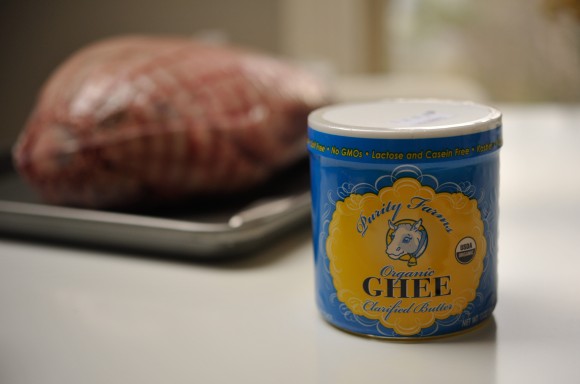
Lamb Mechoui is typically a large cut of lamb such as a leg or a shoulder, smothered in smen (a type of fermented, aged butter), and coated liberally with spices. It’s not impossible to find smen around here (I’ve seen it at Russo’s), but it is expensive.
Joyce Goldstein mentions in ‘Saffron Shores: Jewish Cooking of the Southern Mediterranean’ that the Jews actually made a version of Mechoui, although it certainly wouldn’t have had any butter, as Jews don’t mix milk and meat.
For this recipe, I decided to use Ghee – clarified butter which has been removed of dairy solids. Ghee is sweeter than smen, but plays well with the spices, and I cook with it often. It’s also Paleo friendly and Whole 30 approved, if that matters to you! I’ve made my own with Kerrygold Butter, but was in a pinch this weekend, so picked up a large jar from Purity Farms.
I usually keep ghee at room temperature, but I softened it for a few seconds in the microwave so I could work the spices into it easily. The first step was to work in the salt and the saffron.
You don’t have to make this with saffron, but it lends a lovely unique flavor. When my mom went to Istanbul this summer, I asked her to bring me back kilos of spices from the spice bazaar, including a good amount of saffron threads. These come from Turkey, but I also have a stash from Spain. There’s always a big controversy over the legitimacy of saffron, but as far as I can tell, these both are as real as you can get. A small amount of saffron goes a long way!
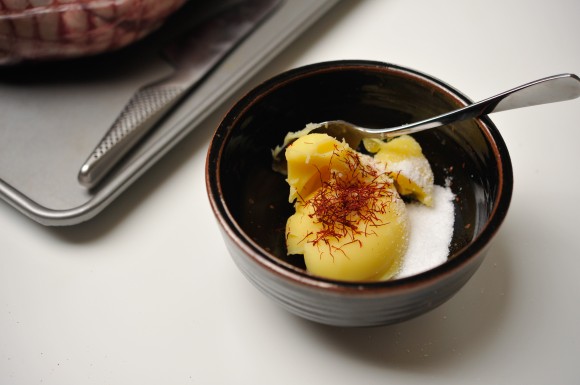
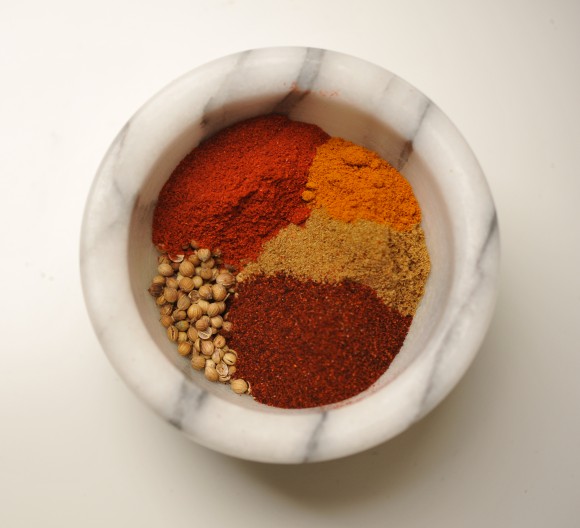
The rest of the spices I added were coriander (typically I use ground, but I had run out, and it’s always easy to bash some in the mortar and pestle), cumin, chile powder (I get mine from Rancho Gordo), paprika, and turmeric.
Before spreading on the paste, I stabbed the lamb a dozen times, and stuffed the holes with sliced cloves of garlic. Then, I did my best to coat both sides with the spice mixture.
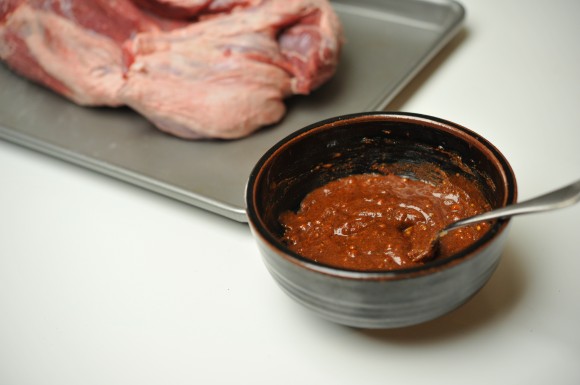
After coating the lamb, I let it sit at room temperature for two hours, to let the flavors permeate, and to ensure that the large piece of meat was fully at room temperature to help it cook evenly. I then transferred it to my large Le Creuset dutch oven, added a half cup or so of water, covered the pot with the heavy lid, and popped it in a 350 degree oven.
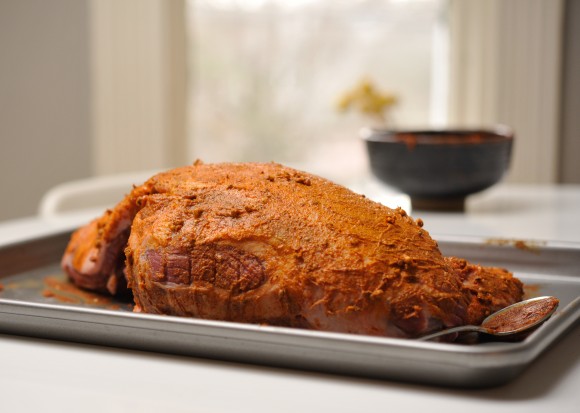
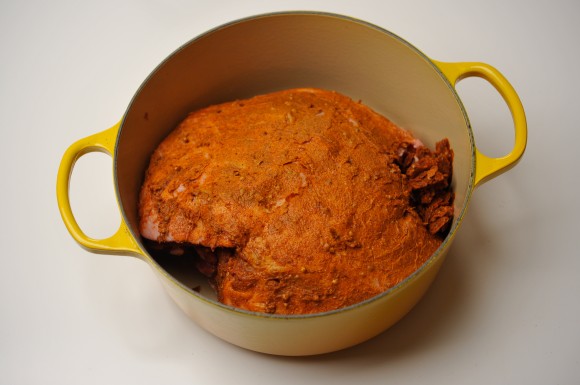
While in the oven, it requires a little attention – basting every 30-45 minutes with a turkey baster. I let it cook for just under three hours, then uncovered the pot, and let the skin crisp up a little bit for about 30 minutes. Then I took the lamb out to rest, put the pot on the stove top, and cooked down the juices into a thick, lamb-y sauce.
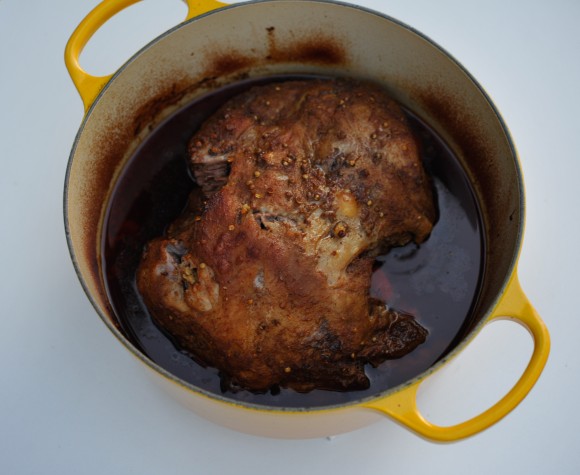
The final result was moist, tender, and exceedingly delicious. For an authentic eating experience, you might just ladle a bowl full of sauce, and dip pieces of lamb first in the sauce, then in some cumin and salt. I decided to have some balanced vegetables, and made some carrot salad to accompany it – the recipe is below!
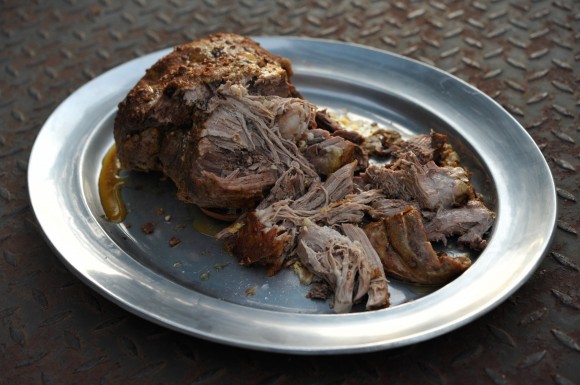
Lamb Mechoui
The boneless leg of lamb from the American Lamb Board was a hefty 8 pounds, but this recipe is scaled down to a four to five pound roast.
1 leg of lamb (or shoulder)
4-5 cloves of garlic, sliced
50 grams of smen or ghee (about 1/2 stick of butter), at room temperature
1/2 teaspoon of saffron threads
1 Tablespoon kosher salt
1 Tablespoon ground coriander
1 Tablespoon ground cumin
2 teaspoons chile powder
1 teaspoon sweet paprika
1/4 teaspoon turmeric
Take the lamb out of the refrigerator, and cut slits in the lamb. Slice the cloves of garlic, and insert into slits.
In a small bowl, mix softened ghee (or smen or butter) with threads of saffron and salt. Then add cumin, coriander, chile powder, paprika, and turmeric, and stir into a paste. Liberally rub the lamb on the inside and out with the mixture, and let rest for an hour or two at room temperature.
Preheat the oven to 350 degrees for half an hour. Place the lamb in a large dutch oven, skin side up. Pour about half a cup of water into the bottom of the pot, cover, and place into the hot oven. You can also make this in a deep roasting pan, being sure to cover tightly with a double layer of foil. Cook for about 3 hours, basting every 30 – 45 minutes. (It could take shorter or longer depending on the size of your roast.) The meat should be tender, and pull apart with a fork. For the last half hour, remove the lid, and let the skin crisp up.
Transfer the lamb to a platter, and let rest for 10 minutes, before shredding with a fork. While the meat is resting, put the pot with all the juices on the stove, and bring to a low boil, reducing for 10-15 minutes until the liquid is concentrated. Serve the shredded lamb with the lamb reduction, wedges of lemon, and salad accompaniments. (A little bit of yogurt, drizzled with a little bit of olive oil, topped with a few pomegranate seeds is nice here.)
* * *
This lamb dish is quite rich, and needs a tart salad to brighten things up. For our feast, I put together Moroccan Marinated Carrots – my favorite go to salad.
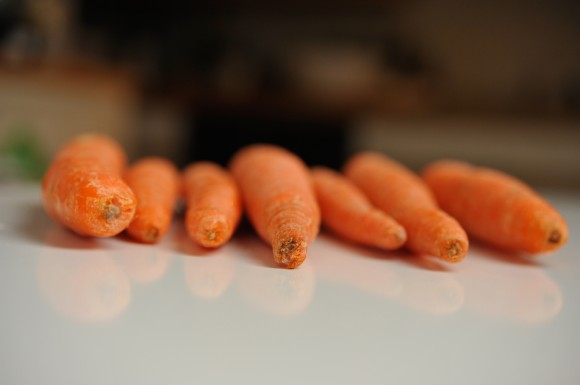
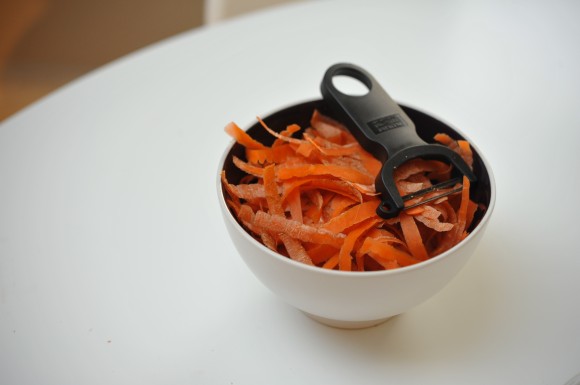
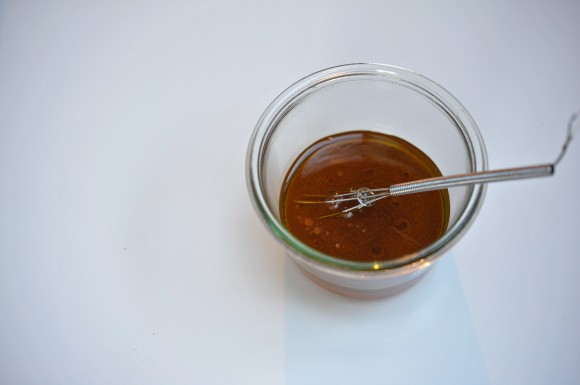
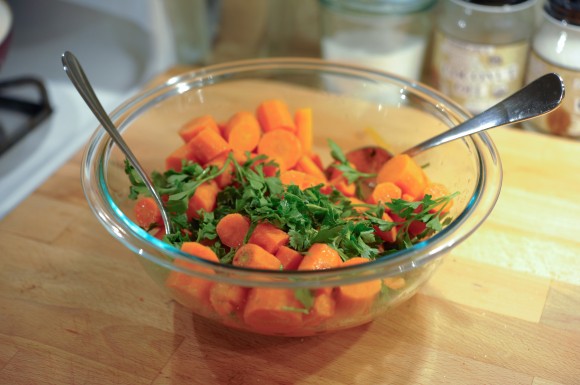
Moroccan Marinated Carrots
I make a version of this salad on a regular basis, sometimes substituting roasted, or even raw shredded carrots for the steamed ones I’ve used here. The garlic powder is untraditional (and possibly tacky), but it dissolves well in the dressing. Sometimes, I add a little bit of runny honey to bring out the sweetness. It’s a bright, spiced side, that goes well with all types of roasted and grilled meats. Or, you could add chickpeas and toasted almonds, for a vegetarian meal. A fistful of mint is also a nice addition.1 pound carrots, peeled and cut on the bias into thick rounds.
1 clove garlic
1 tablespoon ground cumin
1/2 teaspoon ground coriander
1/2 teaspoon paprika
1/2 teaspoon garlic powder
1/2 teaspoon cayenne pepper
a few large pinches kosher salt
juice of a lemon
olive oil
a large handful chopped parsley
In a large pot of boil in boiling, salted water, add the carrots and garlic, and boil 6-8 minutes until soft. Drain. (Or, steam carrots in the microwave for 5 minutes with a little bit of water.)
In a small bowl, add cumin, coriander, paprika, cayenne, salt and lemon juice. Whisk together, and slowly pour in olive oil, whisking to combine. Pour over warm carrots, and then let marinate – at least half an hour, or overnight in the fridge. Lasts quite well for three to four days, although I usually add a new handful of fresh herbs to perk things up.
* * *
Please vote for me here: http://bit.ly/ProAm2013 (Voting will end next Friday, 4/26 at 5pm)
I received a leg of lamb from the American Lamb Board and BostonChefs.com to create a recipe with, although I was not compensated for this post. My opinions of lamb are my own – ewe can count on it!
by Sam Tackeff | Apr 14, 2013 | Pantry Staples, Quick and Easy, Vegetables
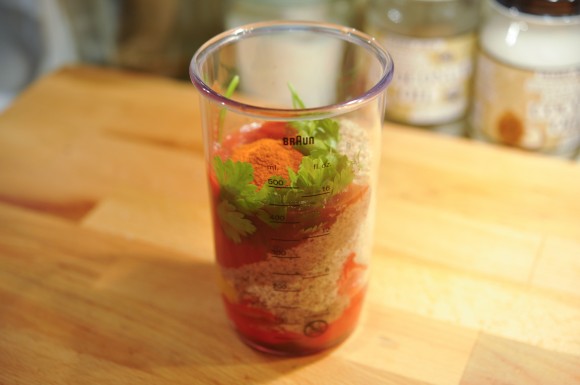
I was going to share this recipe last week, but then noticed that Ken and Jody had a wonderful post on Romesco with Grilled Spring Onions, and I suffered a short bout of blogger envy. Mine is the quick version, but be sure to swing over to theirs and check out the gorgeous photos – and then go ahead and make some Romesco! It’ll take you ten minutes, and you’ll be happy all week long.
* * *
I’ve really been enjoying the new era of Bon Appétit with Adam Rapoport at the helm. It feels like they’ve made a good comeback and successfully refreshed themselves. The creative direction feels modern and relevant, and they have been taking chances on some great up-coming photographers. (It was a treat to see the work of Kimberley Hasslebrink and Brian Ferry in recent issues.) Lately I’ve been really excited for each issue to arrive – and when it does, I find myself flagging multiple recipes to try, and actually heading in the kitchen to cook them.
As part of this year’s kitchen resolutions, I’ve been trying to make a new sauce every week – sometimes a pesto, salsa verde, or chimichurri. Or even a good mayonnaise spike with fresh herbs and garlic. Having a sauce on hand is a good incentive to cook when you are feeling uninspired – you know you already have one component finished, a perfect accompaniment to chicken, roasted vegetables, spooned on eggs, or to refresh leftovers.
A few months ago I had flagged a segment of the magazine called “Master Fresh and Easy Sauces”, which had an entire selection of sauces I’d be interested in eating: Romesco, Green Harissa, Avocado-Lime Sauce Vierge, Kimchi Relish, and Charred Lemon-Shallot Chutney. The Romesco made the cut because I had all of the ingredients already in my pantry.
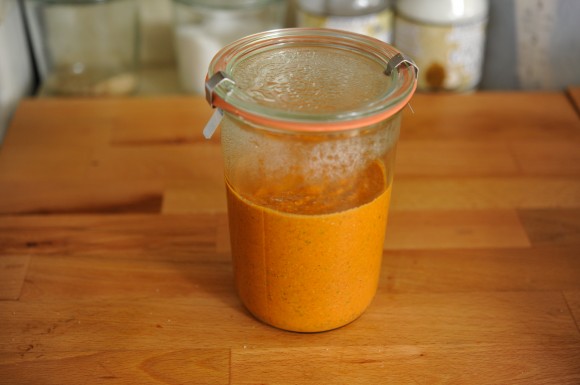
Romesco
adapted from Bon Appétit January 2013
(Recipe by Soa Davies)
The original recipe called for one large pepper, although I used 1/2 the jar from Trader Joes (about 3 medium ones), and substituted almond meal for toasted slivered almonds. I think you’d get a little bit more depth from toasting, although frankly I found that the sauce had enough punch without. For the tomato purée, I’ve used both Italian passata and Trader Joe’s tomato sauce in the can with success here.
1 large roasted red bell pepper from a jar
1 garlic clove, smashed
1/2 cup almond meal
1/4 cup tomato purée
2 Tbsp. chopped flat-leaf parsley
2 Tbsp. Sherry vinegar
1 tsp. smoked paprika
1/2 tsp. cayenne pepper
1/2 cup extra-virgin olive oil
sea salt and freshly ground black pepper
In a food processor, pulse the first 8 ingredients until finely chopped, and add slowly add olive oil until smooth. Or, if you can’t exercise patience, put all of the ingredients into a large cup, and blend with your immersion blender. (Quick, less to clean, and just as delicious.)
Makes 1 1/2 cups. Keeps in the fridge for a week.
by Sam Tackeff | Apr 10, 2013 | Books

I was listening to NPR last week in the car on the way to the gym – that’s when I do the bulk of my NPR listening – and the oddest piece was on ‘This American Life‘ about people who get a tingle feeling in their brain from listening to whispering and other noises. This tingle has a name – it’s called “Autonomous Sensory Meridian Response” or ASMR for short. And apparently some folks with ASMR get so addicted to the tingle that they spend a lot of time actively seeking out videos that activate said tingling. Which, curiously, has led to the proliferation of whispered “haul videos” where bloggers (vloggers?) go over a haul of things which they just purchased, except in a whispered voice.
So after listening to this story, and poking around the internet for more ASMR videos, I realized that I have the tingle. But apparently I just hadn’t noticed it very often – but now that I know what it is, I definitely do, and it’s weird. Whispering will set it off, but so does the whistling of my old metal heaters, and a host of other sounds. I don’t know how I feel about this new realization – I’m just glad I don’t feel obsessed to watch hours of videos every day to activate it.
Where am I going with this? Oh, yes. Haul videos. Okay, so here’s my version of the haul – cookbooks. I’m not going to whisper them to you, but here’s my most recent acquisitions, from a trip to the glorious (and very dangerous) New England Mobile Book Fair. It’s not actually mobile. It’s a bookstore full of new, old, and obscure books housed in a warehouse. They have a massive amount of cookbooks, including a huge selection of remaindered and out of print titles. Usually when I purchase cookbooks these days, it’s older books which are out of print, or UK titles that haven’t come out in the states yet.
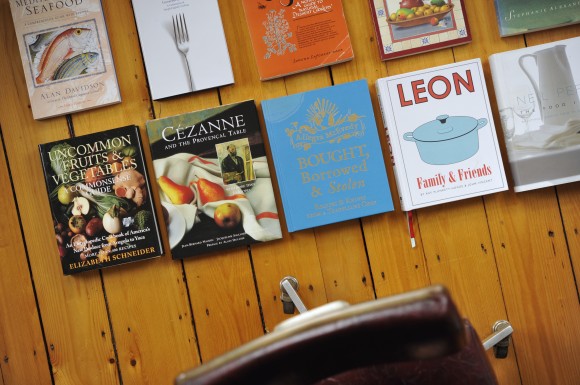
{FYI – this is what your photos turn out like if you try to balance on a rolling office chair to take a shot.}
1. Alan Davidson ‘Mediterranean Seafood’. This came out in the early ’70’s, and is a useful compendium of seafood, part encyclopedia, with a handful of recipes. I’m a sucker for the more ‘educational’ title like this one.
2. ‘Kettle Broth to Gooseberry Fool’ – Jenny Baker. I was unfamiliar with Jenny Baker, but enticed by this little book of simple English cooking.
3. ‘Honey & Spice: A Nutritional Guide to Natural Dessert Cookery’ – Lorena Laforest Bass. This one will sit on my shelf next to my worn ‘Laurel’s Kitchen’, and Tassajara cookbooks. Nothing quite like the late 70’s/early 80’s hippy genre – mostly because I find myself actually inspired to cook from these titles. They were on top of the home made Lara Bar before I was even born.
4. ‘Nothing Fancy’ – Diana Kennedy. Diana Kennedy is one of my heroes, and I hadn’t seen this one before. There’s one review on Amazon for this book – “The recipes are unusual and not what I would cook. It is fancy. This book is mis-titled. The title does not tell how the recipes are.” Clearly the reviewer would not enjoy Diana’s most recent ‘Oaxaca al Gusto’ either.
5. ‘Stephanie’s Seasons’ – Stephanie Alexander. I’ve been on the hunt for an inexpensive copy of Stephanie Alexander’s ‘The Cooks Companion” for quite some time now, but this is a nice consolation prize. Similar to my favorite cookbook of all time (Nigel Slater’s Kitchen Diaries), this cookbook is a snapshot of her year in food.
6. ‘Uncommon Fruits & Vegetables’ – Elizabeth Schneider. Another encyclopedic food book that I’m so fond of. I loved recommending this title at Omnivore, and finally came around to getting myself a copy.
7. ‘Cézanne: A Taste of Provence’ – Naudin, Plazy, Saulnier. One of my favorite cookbooks growing up was Monet’s Table, and since then I’ve actively tried to collect books about artists and food. Artists, who operate with a higher level of criticism of the world, tend to be highly opinionated about cuisine.
8. ‘Bought, Borrowed and Stolen’ – Allegra McEvedy. Allegra was one of the founding members of Leon, a healthy restaurant empire in the UK. This cookbook is about her extensive traveling, collecting knives!, recipes, and stories from around the world.
9. ‘Leon: Family & Friends‘ – Kay Plunkett-Hogge. Leon, the aforementioned restaurant in the UK has their newest cookbook out, and it’s just as stellar as the previous three. (Some of my favorite cookbooks!) I’ve already spent a good deal of time flipping through this and using it as inspiration for dinners. Highly recommended!
10. ‘Foods I Love’ – Neil Perry. I love Neil Perry’s style, and this book is full of simple recipes with detailed explanation of technique and variation.
I read cookbooks like novels, and I’ve already made my way through half of these. All great so far! What are your most recent cookbook acquisitions?
by Sam Tackeff | Apr 8, 2013 | Condiments, Pantry Staples, Quick and Easy
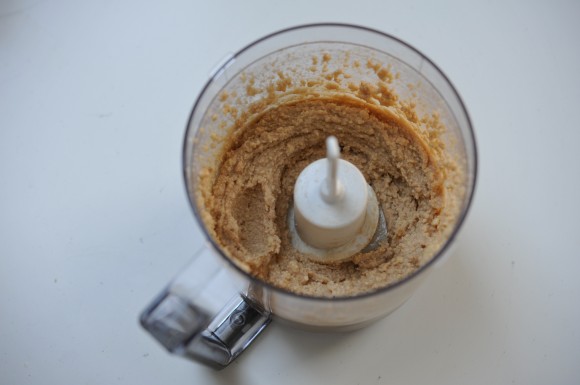
A few years ago, after working on Karen Solomon‘s book ‘Can It, Bottle It, Smoke It‘, I became a home made condiment convert. The secret about condiments is that they usually have no more than a handful of ingredients and come together in a television commercial break. Which doesn’t matter any more because of the miracle of the DVR – but believe me in high school and college, many foods were deemed suitable or not based on how much prep I could do during a two minute interlude while watching Buffy or ER.
I’m not saying that everyone should be making their own coconut milk or marshmallows (although, frankly both are doable and fairly easy). But nut butters, ketchups, and all sorts of sauces are my favorite things to cook, and turn out so much better than the packaged variety. And yet… I still am tempted to pick these things up and put them in my basket at the store – because those are the things you never want to run out of. To remedy this, I put together a little condiment calendar, of special things I wanted to try to make at home. My goal is to make a useful condiment in bulk at least once a month. For a while it was once a week, but I like making achievable goals and then outdoing myself.
So nut butters. From start to finish, no more than 10 minutes, and you have glorious, fresh nut butter, which you can flavor however you’d like.
Truthfully, it had been a while since my last nut butter batch. And then I joined a gym challenge where pre-packaged nut butters, nut milks, and any sort of additives were verboten. We were however allowed both nuts and coconut oil, and our kitchen – so this week I whipped up a batch of cashew butter with coconut and cinnamon. (I was tempted to make my own fresh coconut milk for curries, but I thought that would be pushing it with the rules and the spirit of things.) I’m actually better at portioning out nut butter than I am nuts – I know that 2 tablespoons of nutter butter is a serving and not to go over – but three and you are pushing that. Give me a handful of whole nuts, and I’ll go back for handful after handful, until I’ve eaten the entire bag.
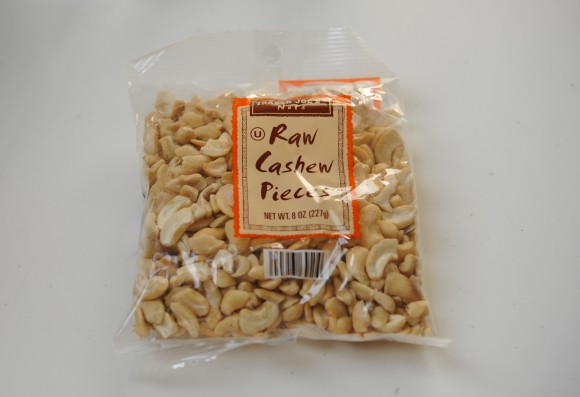
So cashew butter. I like cashews because they are creamy and naturally sweet, and make a great unsweetened paste. You can make your own nut butter of any type – almonds, pecans, pistachios and hazelnuts all are great. You can use walnuts, although I find walnuts to be slightly bitter for my taste.
Usually I pick up these raw cashew pieces from Trader Joe’s. They are cheaper than the whole cashews, and come in a convenient 8 oz. package, which is more than enough for a batch for one person.
You usually need a little bit of fat to blend the nut butter – I like melted coconut oil because it gives it a hint of coconut taste, without tasting overtly coconut-ty. If I were making a savory nut butter (have you had one before? It’s interesting!), I might use olive oil. With cashews I like adding a little bit of vanilla, cinnamon, and salt. But you can also add cocoa powder, and make your own Nutella – if you want to get fancy, add a little bit of chile powder.
Another seasoning trick is to find a good recipe for spiced nuts – you know, the kind your grandmother used to serve with cocktails – and then just blend them into a nut butter.
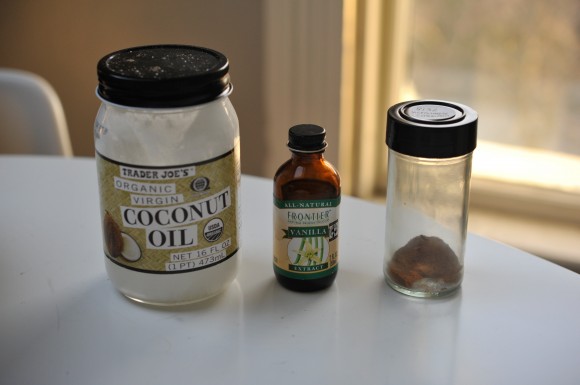
For this batch I kept it simple.
Into my baby Cuisinart Mini-Prep (on sale at Amazon for 47% off) – this thing is a workhorse, and perfect for a small household. And you can dish wash!
Blend, blend, blend.
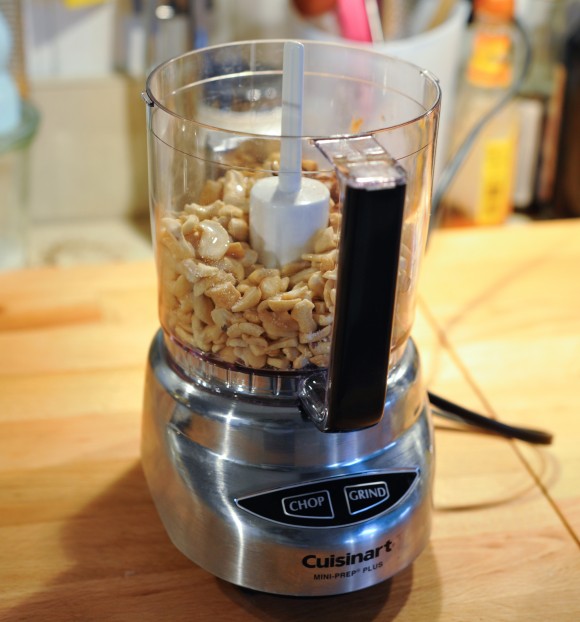
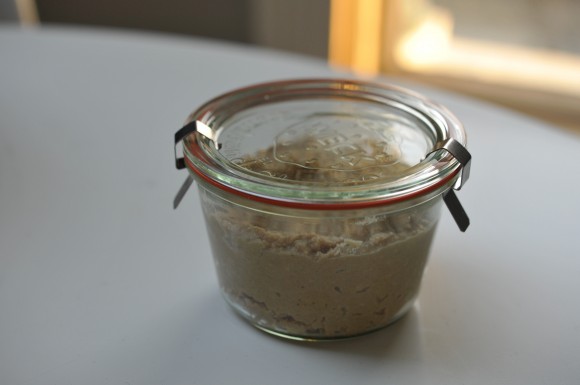
Homemade Cashew Butter
This nut butter is best made with raw cashews, which you can purchase at Trader Joe’s for an affordable price. I typically make a small amount – about a cups’ worth – primarily to avoid eating several cups worth of nut butter in a single week. The recipe is easily double-able, and I’d actually recommend doubling if you are using a larger food processor, as the small amount won’t blend as well.
8 oz. raw cashews (225 grams)
1/4 cup coconut oil, melted
1/2 teaspoon cinnamon
1/2 teaspoon vanilla extract
a pinch of salt
In the bowl of a small food processor, place the cashews, cinnamon, vanilla and salt, and pour over the melted coconut oil. Pulse to get the mixture started, scraping down the sides with spatula. You want to get the nut butter going, and then grind for a minute or two at a time, until a smooth paste is formed. I usually do a minute on, scrape the sides, another minute, scrape, a third minute – you can do it for a few extra minutes if you want a very smooth paste, but I like mine a little bit chunky. It also helps to give your processor 30 seconds of rest if the motor is overworked.
You can store this in the fridge for a few weeks but it’ll firm up. I’m okay leaving it out on a cool countertop for a few days – which is as long as it’ll last in the house.
Makes about 1 1/4 cups.
by Sam Tackeff | Apr 6, 2013 | Lunch, Wellness
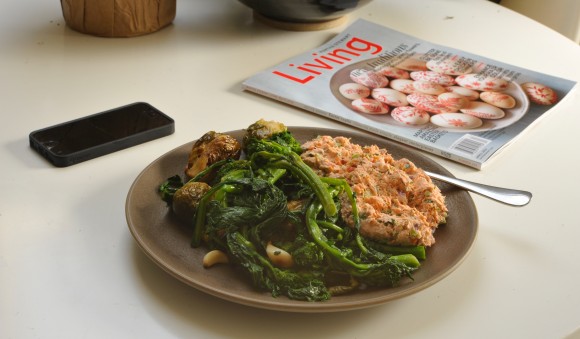
For most people, the weekend is a time for indulgence and excess, but for me, the weekend is about relaxation, rejuvenation, and making healthy choices. For the past few months, I’ve been settling into my work rhythm, trying to balance my new role and responsibilities with my passion for being active. I feel so lucky to be working for a fitness company that allows me to leave early once a week to head to the gym – as long as I’m getting my work done – but I do really miss my noon workouts from when I was working from home. So instead of sleeping in on weekends, I try to get in a double dose, heading in both Saturday and Sunday for what feels like adult recess.
This past five weeks, I’ve been competing in the CrossFit Open, pushing myself to the upper limit of my athletic ability. Week one we tackled dreaded burpees and snatches, week two had me pushing hard with the 75 pound shoulder to overheads, week three I got in more than a hundred wall balls at 20 pounds when I had previously been using an 8 pound ball in workouts. Week four was my absolute nemesis, fighting multiple days to get the *single* rep I needed to move on to round five. 95 pounds was 10 more than my PR for the clean and jerk, and my form (not the weight itself) was holding me back. It was a collective gym effort to get me to that rep – and after days of no success, Coach Steve helped me make magic happen and I got it done. This week was a deadly combo of thrusters and chest to bars. I’ve been able to muscle a handful of chest to bars this week, but couldn’t manage them after the first set of thrusters. But I’m getting there. And with each new PR, I feel stronger and more confident to keep pushing myself. Every single day I feel thankful for how far I’ve come, and for how it makes me feel as I set about conquering life.
Unlike my grandfather, who used to barter gym time for a donut and a cigarette – I like to reward myself for my workouts with a cup of black coffee, and a highly nutritious meal. (I do think that he’d have been amused and proud of my athletic achievements, given the turnaround from my sedentary teenage hood.)
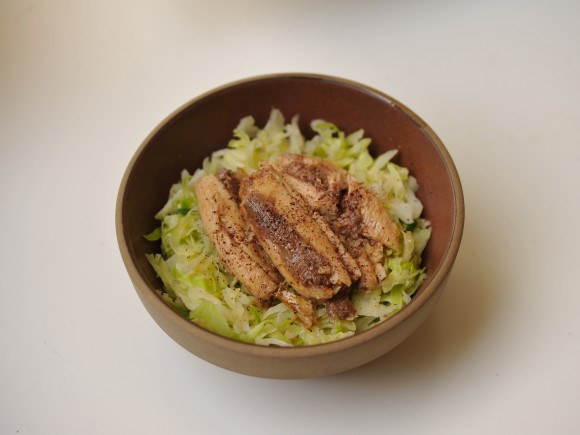
I make sure I’m getting in lots of greenery – pounds of leafy greens, especially if I haven’t been the most attentive during the week. I’ll usually cook up a large bag of collards or what Trader Joe’s calls “power greens”, sometimes with a bit of bacon, or plain with a little bit of garlic, shallot, and cider vinegar, and use them as the base for the majority of my meals.
I’m particularly fond of making salmon salad (see above, with the heaping portion of broccoli raab and garlic), or opening up a tin of sardines, and making a dressing with the fish infused olive oil and some fresh lemon juice. The photo has them served over some steamed green cabbage, and sprinkled with some bourbon smoked paprika. I try to eat little fishes at least once a week, but sometimes I’m negligent. Really, you can’t go wrong with sardines.
On cloudy or cold days, I go with soup. This was a beef, tomato, and carrot soup I picked up from Formaggio Kitchen a few weeks ago, and savored it while simultaneously reading my Kindle, flicking through Twitter, and with my computer at arms reach. Some of my habits are less healthy than others.
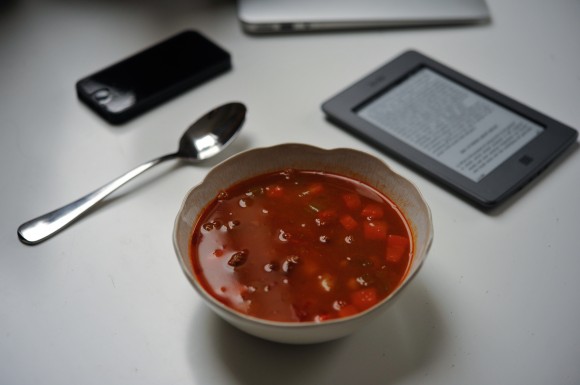
And then, there’s my favorite lunch staple: the avocado. I went nearly three weeks without avocado last month, and it was a travesty. Here’s my new favorite – avocado halves with sherry vinegar, salt, and a sprinkle of black pepper. If you can find a nice ripe avocado, try eating it this way, you won’t be disappointed.
